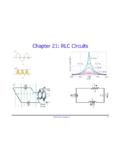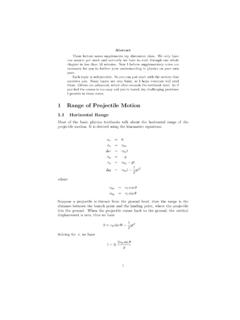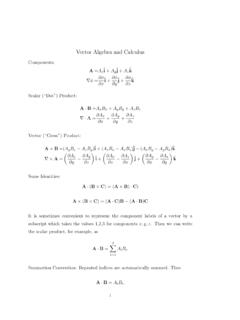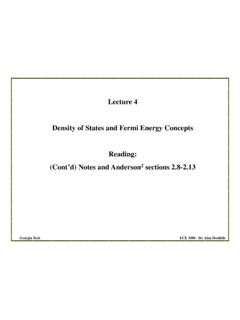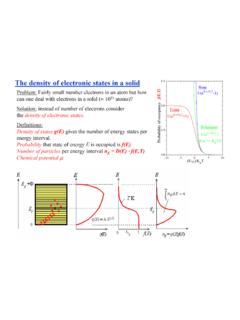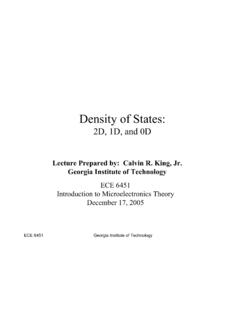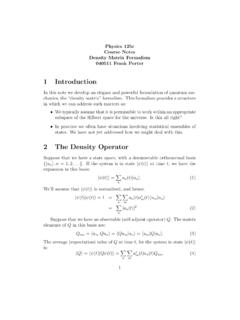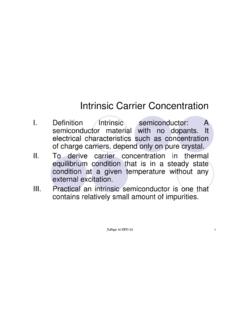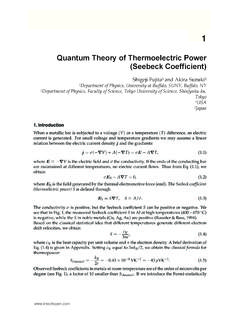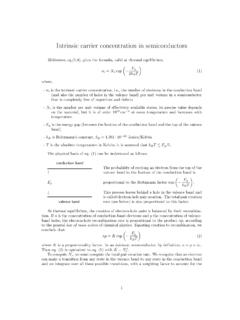Transcription of Scattering in Quantum Mechanics - University of Florida
1 1 Paul Avery PHZ4390 Sep. 25, 2013 Scattering in Quantum Mechanics 1 Rutherford Scattering .. 1 Derivation of the classical Rutherford Scattering formula .. 1 Using the momentum transfer q .. 3 2 General Formula for Scattering in Nonrelativistic QM .. 3 3 QM Scattering from a Coulomb Potential .. 5 Derivation of Scattering cross section .. 5 Matrix element and Feynman diagram for coulomb Scattering .. 5 Example: large angle Scattering in the Rutherford experiment .. 6 Coulomb Scattering of two finite mass particles .. 7 4 QM Scattering from a Potential with Massive Particle Exchange .. 8 Fixed potential .. 8 Two interacting particles: weak interactions .. 9 5 Appendix: Density of States .. 10 Derivation of density of states formula .. 10 Example 1: Total density of states for p pmax .. 10 Example 2: Density of states and Maxwell velocity distribution.
2 10 Example 3: Density of states and Planck photon energy distribution .. 11 Example 4: Fermi momentum at low temperature .. 12 1 Rutherford Scattering Our understanding of Scattering goes back to the Rutherford-Geiger-Marsden Scattering experi-ments of 1909 which aimed to measure the structure of atoms. The experimenters used radium and a collimation system to produce a narrow alpha particle beam that struck a thin gold foil tar-get in an evacuated chamber. Although most alphas were gently deflected as expected (the pre-vailing atomic model assumed smooth charges embedded throughout the atom), the experiment-ers were astonished to find that a small fraction were scattered at large angles by what they later surmised was a massive, positively charged nucleus occupying a region less than 1/4000 the di-ameter of the atom. In their 1911 paper they derived an equation, known today as the Rutherford Scattering formula, that explained their results in terms of the Scattering of charged particles by a heavy point charge.
3 Derivation of the classical Rutherford Scattering formula Consider a beam of particles, each of mass m and charge e, incident on a heavy nucleus of charge Ze, where the nucleus is assumed not to move ( M m). Each beam particle will be deflected, depending on its momentum p and impact parameter b, through an angle , as shown in Figure 1. 2 Figure 1: Scattering of a particle of charge e by a heavy nucleus of charge Ze. The force acting on the beam particle is F=Ze2/4 0r2=Z /r2 in natural units, where r is the distance between the particles. We can determine the angle of Scattering from the following argument. After the Scattering the beam particle momentum p is unchanged (elastic Scattering ), but it is deflected by an angle . Thus py=psin . But we can also calculate py by integrating the force along the y direction. Let be the angle measured from the nucleus to the particle start-ing from the x-axis, with.
4 Then using py=Fsin dt , we obtain py=Z r2sin dt =Z r2sin dtd d =Z bvcos =Z bv1+cos () where r2 =bv from angular momentum conservation. We thus obtain a relation between the Scattering angle , momentum p and impact parameter b: psin =Z bv1+cos () tan12 =Z pvb We are interested in finding the cross sectional area d corresponding to a particle Scattering into the small angular region to + d . This will happen if the particle has an impact parameter be-tween b and b + db, if it lies in an annulus of radius b centered on the nucleus. The area of the annulus is d =2 bdb and using the relation just derived for tan12 b=Z pvcot12 db=Z 2pv1sin212 we obtain d =2 bdb=2 Z ()22p2v2cos12 sin312 =Z ()2p2v22 sin d 1 cos ()2 !bp 3 The right-most expression was obtained by multiplying numerator and denominator by sin12 and applying the half-angle trig identities sin =2sin12 cos12 and 1 cos =2sin212.
5 Since the Scattering process does not depend on (axially symmetric Scattering ), d =2 and we can write the numerator of the rightmost fraction as 2 sin d d , the differential of solid angle. We thus obtain the well-known Rutherford differential cross section: d d =Z c()2p2v211 cos ()2 where I have restored the c term. Two things should be noted: (1) c=e2/4 0 so this clas-sical result does not depend on the QM-related quantity ; (2) integrating over d =2 dcos d gives an infinite total cross section, a consequence of the infinite range of the coulomb force. Using the momentum transfer q It s conventional to write the cross section in terms of the momentum transfer q=pi pf (ini-tial minus final momentum), where q2=2p21 cos (). The Rutherford formula then becomes d d =4Z cm()2q4 In QM Scattering theory we normally express the differential cross section in terms of q2 or the Lorentz invariant quantity q2.
6 These are the same up to a sign for elastic Scattering ( Ei Ef). 2 General Formula for Scattering in Nonrelativistic QM We can compute cross section formulas in nonrelativistic QM. The rate dJ for a process to pro-ceed from an initial Quantum state i to a final state f is given by the Fermi Golden Rule: dJ= fM i2 dNf 2 Ef Ei() where fM i= fM id3x describes the QM transition, dNf is the differential number of states for final state f (derived in the Appendix) and Ef Ei() is a delta function enforcing energy conservation. The term phase space is used for the dNf term. In relativistic Scattering phase space generalizes to multiple particles in the final state and has a delta function for 4-momentum conservation. For Scattering processes, we assume that we have a free particle in the initial state before scatter-ing and a free particle in the final state after Scattering . Thus, for a Scattering potential U(x), 4 ix()=1 Veipi x fx()=1 Veipf x fM i=1 VUx()eiq xd3x dNf=Vd3pf2 ()3 where q=pi pf is the momentum transfer and I have used natural units.
7 To get a cross sec-tion, we use the standard expression dJ=jiNtd (derived in a previous note) with one target particle ( Nt=1) and a plane wave flux density ji=nivi=vi/V (a single beam particle in the volume moving at velocity vi). When we divide the rate by the initial flux the volumes cancel and we obtain: d =dJjiNt=1viMfiq()2d3pf2 ()32 Ef Ei()=1viMfiq()2pf2d f4 2dpf Ef Ei() Mfiq()=eiq xUx()d3x , the Fourier transform of the potential, is called the matrix element . We can integrate out the delta function using a standard variable change dpf Ef Ei() =dpfdEfdEf Ef Ei() =dpfdEf=1vf using dpf/dEf=1/vf, which holds true even for relativistic momenta. We finally obtain a general formula for the differential cross section: d d =Mfiq()2pf24 2vivf This formula allows the scattered particle to change species with different masses, though nor-mally vi=vf. Note that all the physics is in the matrix element Mfiq(); everything else is kin-ematics and phase space.
8 5 3 QM Scattering from a Coulomb Potential Derivation of Scattering cross section Here the potential is Ux()=Z /r. We calculate Mfiq()eiq xZ /r()d3x =4 Z /q2 (left as an exercise1) and get the cross section (using vi=vf in the final step) d d =Mfiq()2pf24 2vivf=4 Z ()2q4pf24 2vivf=4Z2 2m2q4 which agrees exactly with the classical Rutherford formula. The graph in Figure 2 shows the Rutherford differential cross section for particles on gold for 1 cos Figure 2: Rutherford differential cross section (barn/steradian) vs cos Matrix element and Feynman diagram for coulomb Scattering Scattering from a fixed coulomb potential is represented by the Feynman diagram in Figure 3. The diagram gives the essential elements of the matrix element. The upper and lower vertices have coupling constants e and Ze, respectively, while the massless photon propagator brings in a factor 1/q2. Putting it all together yields Mfi Ze2/q2=4 Z /q2, which happens to be the 1 This can most easily be shown using spherical coordinates, with eip x=eiprcos and d3x=2 r2drdcos.
9 6 correct answer! For relativistic Scattering in Quantum electrodynamics (QED), there are precise rules that allow one to exactly calculate the matrix element from a Feynman diagram, including all constants and possible internal loops (which we defer to a later discussion). Once the matrix element Mfi is known, the cross section can be calculated by multiplying Mfi2 by phase space and dividing by the flux, as discussed in Section 2. Figure 3: Feynman diagram of particle Scattering from fixed potential Example: large angle Scattering in the Rutherford experiment When Rutherford did his classic experiments about 100 years ago, he used a collimated beam of alpha particles from radium emission to strike a gold target 400 nm thick. Let s calculate the fraction of alpha particles scattered at 90 or more from his formula. Since gold has an atomic mass of ~197, we can safely neglect its recoil. At a density of and a thickness of 400 nm, the foil is only about 1600 atoms thick (Rutherford chose gold foil because it can be processed into extremely thin sheets which minimizes multiple Scattering ).
10 The total cross section for Scattering 90 or more is easily calculated, with Z = 79 for gold and z = 2 for alpha particles, to be 90 ()=Zz c()2p2v22 dcos 1 cos ()2 10 = Zz c()2p2v2 Alpha particles from radium emission have kinetic energies of MeV. Using p2v2=4K2 we use energy units with c= fm to obtain 90 ()= Zz c()24K2= 79 2 ()24 The probability of Scattering through this angle is P= nAu x 4 10 5, so approximately 1 in 25,000 alpha particles will scatter through this angle. Rutherford s team measured 1 in 20,000 (the scatterings had to be counted by hand!). Figure 4 shows the integrated Rutherford cross sec-tion for 1 x cos (). 7 Figure 4: Integrated Rutherford cross section for 1 x cos vs cos Coulomb Scattering of two finite mass particles We can generalize the previous Scattering result to two particles with finite mass. The process is shown in the Feynman diagram in Figure 5.
